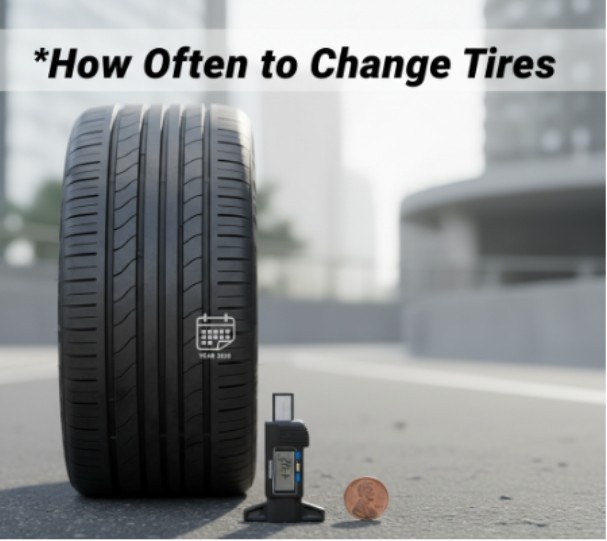My Tire Wake-Up Call
I’ll never forget the morning I hit the highway on what I thought were perfectly fine tires. I was halfway through my coffee when the steering wheel started trembling like a washing machine on spin cycle.
Turns out, those tires were nearly seven years old, the tread was worn thin, and the rubber had hardened like old bread.
That experience sent me down a rabbit hole of researching how often to change tires, and now, I’m borderline obsessed with keeping mine in peak shape.
If you’ve ever wondered when to retire your rubber, you’re in the right place. Let me walk you through the techy but crucial details every driver should know.
How Often to Change Tires Based on Age
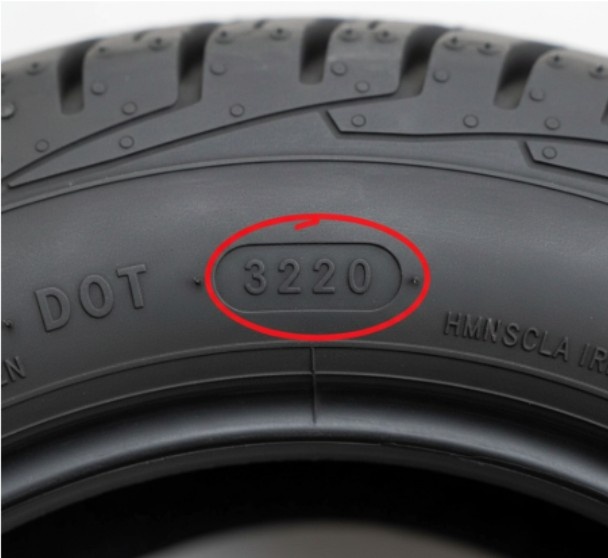
One of the biggest myths I see is that tires are fine as long as the tread looks good. Not true.
Tires have a shelf life, and even if they sit in your garage looking brand new, the rubber compounds break down over time from heat, sunlight, and oxygen exposure.
I stick to what most manufacturers and shops recommend: replace them at six years, max.
That’s the sweet spot where they may still have tread left but are starting to lose elasticity and grip. Once a tire hits ten years old, it’s done—retire it even if it looks showroom-fresh.
There’s a quick way to check the age: look for the four-digit DOT code on the sidewall. The first two numbers are the week, and the last two are the year.
For example, a code of 3220 means it was made in the 32nd week of 2020. I make it a habit to check this whenever I rotate my tires, just to stay ahead of any surprises.
How Often to Change Tires Based on Tread Depth
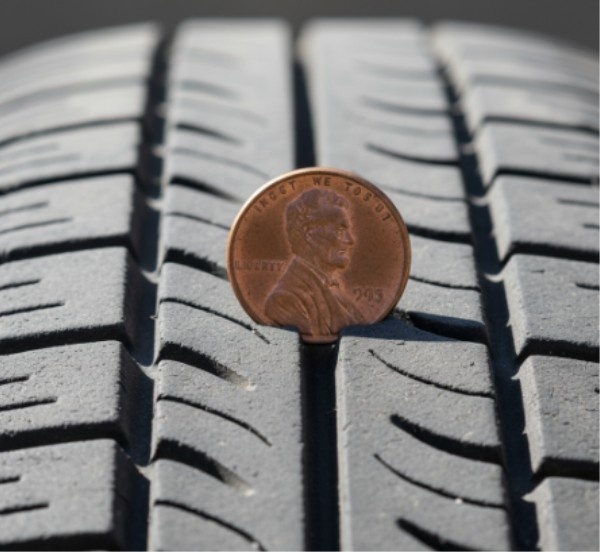
Even newer tires can be unsafe if the tread is worn. Tread depth affects your stopping distance, grip on wet roads, and resistance to hydroplaning—and trust me, you don’t want to find out your tires are bald when it’s pouring rain.
Most tech-savvy mechanics (myself included) use the penny test or quarter test because they’re quick and surprisingly accurate. Stick a penny in the groove with Abraham Lincoln’s head upside down. If you see all of his head, your tread is at or below 2/32 of an inch, which is the legal minimum in the U.S.—time to replace.
If you want to be safer, grab a quarter and use George Washington’s head: if the tread touches his hairline, you’ve got about 4/32 of an inch, which is when I start planning to swap mine out, especially before rainy season.
Another trick: check your tread wear bars. These are small raised ridges inside the tread grooves. When your tread is flush with these bars, the tire has reached its wear limit and needs replacing.
How Often to Change Tires If You Spot Damage
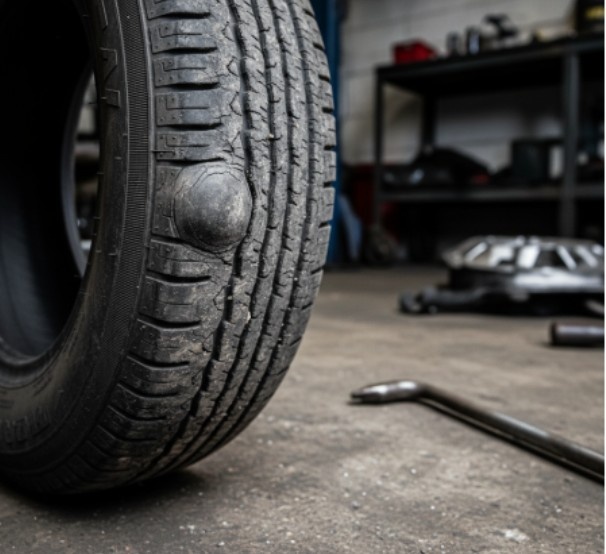
This is the sneaky one people often miss. Even if your tires are young and still have decent tread, visible damage can make them dangerous. A small crack today can become a highway blowout tomorrow.
Once a month, when I’m checking tire pressure, I also scan for:
- Cracks in the sidewalls or tread (a sign the rubber is drying out).
- Bulges or blisters, usually from internal structural damage after a pothole hit.
- Uneven wear, which often means alignment issues or improper inflation.
- Vibration or noise that wasn’t there before. That can signal a shifted belt inside the tire.
I learned this the hard way with a tire that looked fine but had a hidden sidewall bubble. It blew at 60 mph. Don’t wait for that kind of drama—if you see anything odd, get it inspected.
How to Know When All Four Need Replacing
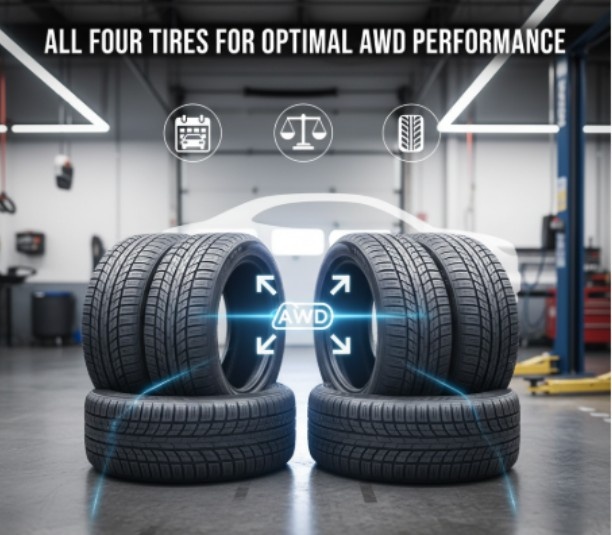
This one’s all about balance and traction. On all-wheel-drive (AWD) vehicles, always replace all four tires at once.
AWD systems depend on all tires spinning at the same rate, and even small differences in diameter from tread wear can mess up the drivetrain.
For two-wheel-drive cars, you can replace two at a time—but always install them on the rear axle.
That might sound counterintuitive, but new tires on the back keep your car stable and prevent fishtailing in wet conditions. I’ve seen countless tests confirming this, and I follow it religiously in my own garage.
Still, I like replacing all four together whenever possible. It keeps the handling consistent, the traction predictable, and makes rotation schedules easier to track.
My Go-To Tire Replacement Checklist
I live by this quick table to decide when to replace tires. Feel free to print it and tape it in your garage:
| Factor | Action |
| Age | Replace at 6 years, 10 years max |
| Tread depth | Replace at 2/32″, shop at 4/32″ |
| Cracks or bulges | Replace immediately |
| Uneven wear | Inspect and replace if low tread |
| AWD vehicles | Replace all four together |
| Only replacing two | Install new ones on the rear axle |
FAQs About How Often to Change Tires
1. How many years do tires usually last?
Most tires last around 3 to 5 years with regular driving. It depends on your habits and roads, but after 6 years, I treat them as done no matter what. Age quietly kills traction, even if tread remains.
2. Is the penny test really reliable?
Yes, it’s a solid way to check for the 2/32-inch legal minimum, but I actually prefer the quarter test. It tells me when I’m at 4/32 inch, which is safer in wet conditions. If you want exact numbers, a cheap tread depth gauge works wonders.
3. Can old tires be safe if they look fine?
Honestly? Not really. Tires can look brand new and still be dangerously brittle inside. Once they hit six years, I recommend replacing them even if they’ve barely been used. Rubber doesn’t age gracefully.
4. Do I need to replace all four tires at once?
If you drive an AWD, yes—always. Uneven diameters can damage your drivetrain. If you have a two-wheel-drive car, you can do two at a time, but always mount the new pair on the rear axle for better stability.
Rolling Out Smooth: My Final Take
If there’s one thing wrenching on cars has taught me, it’s this: tires are your unsung heroes.
They handle every stop, turn, and sudden downpour, and yet most people forget about them until they fail.
Staying ahead of the curve on how often to change tires isn’t just about performance—it’s about safety, confidence, and peace of mind.
So next weekend, grab a flashlight, a penny, and a cup of coffee. Give those tires a proper once-over. Your car—and your future self flying down the highway—will thank you for it.

